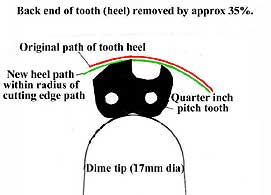SteveSr
Addicted to ArboristSite
Hello,
Freshly sharpened semi-chisel chain and I took a little off the rakers but didn't bother to profile the leading edge like Stihl suggests.
I noticed that the chain limbed and cross cut well. However I noticed considerable vibration and bucking when bore cutting a 10" diameter piece of maple. I also noticed similar similar vibration and bucking when trying to slab (rip cut) the stump of the same maple tree.
So what is the likely cause of this vibration and roughness? Is it related to the non-profiled rakers or is there some other sharpening defect that I should look for and remedy?
Freshly sharpened semi-chisel chain and I took a little off the rakers but didn't bother to profile the leading edge like Stihl suggests.
I noticed that the chain limbed and cross cut well. However I noticed considerable vibration and bucking when bore cutting a 10" diameter piece of maple. I also noticed similar similar vibration and bucking when trying to slab (rip cut) the stump of the same maple tree.
So what is the likely cause of this vibration and roughness? Is it related to the non-profiled rakers or is there some other sharpening defect that I should look for and remedy?






